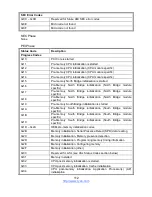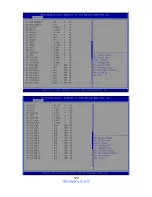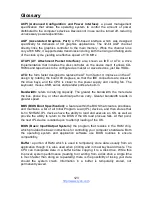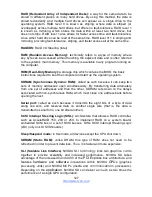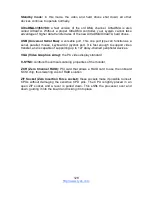
http://www.tyan.com
124
Bus:
a data pathway. The term is used especially to refer to the connection
between the processor and system memory, and between the processor and PCI or
ISA local buses.
Bus mastering:
allows peripheral devices and IDEs to access the system memory
without going through the CPU (similar to DMA channels).
Cache:
a temporary storage area for data that will be needed often by an
application. Using a cache lowers data access times since the information is stored
in SRAM instead of slower DRAM. Note that the cache is also much smaller than
your regular memory: a typical cache size is 512KB, while you may have as much
as 4GB of regular memory.
Closed and open jumpers:
jumpers and jumper pins are active when they are “on”
or “closed”, and inactive when they are “off” or “open”.
CMOS (Complementary Metal-Oxide Semiconductors):
chips that hold the basic
startup information for the BIOS.
COM port:
another name for the serial port, which is called as such because it
transmits the eight bits of a byte of data along one wire, and receives data on
another single wire (that is, the data is transmitted in serial form, one bit after
another). Parallel ports transmit the bits of a byte on eight different wires at the
same time (that is, in parallel form, eight bits at the same time).
DDR (Double Data Rate):
a technology designed to double the clock speed of the
memory. It activates output on both the rising and falling edge of the system clock
rather than on just the rising edge, potentially doubling output.
DIMM (Dual In-line Memory Module):
faster and more capacious form of RAM
than SIMMs, and do not need to be installed in pairs.
DIMM bank:
sometimes called DIMM socket because the physical slot and the
logical unit are the same. That is, one DIMM module fits into one DIMM socket,
which is capable of acting as a memory bank.
DMA (Direct Memory Access):
channels that are similar to IRQs. DMA channels
allow hardware devices (like soundcards or keyboards) to access the main memory
without involving the CPU. This frees up CPU resources for other tasks. As with
IRQs, it is vital that you do not double up devices on a single line. Plug-n-Play
devices will take care of this for you.
Summary of Contents for S7086
Page 12: ...http www tyan com 12 2 2 Block Diagram S7086 Block Diagram ...
Page 13: ...http www tyan com 13 2 3 Motherboard Mechanical Drawing ...
Page 18: ...http www tyan com 18 USB3_HD1 USB2_HD1 FAN_HD1 TYPEA_USB3 2 ...
Page 20: ...http www tyan com 20 COM2 SATA5 SATA4 DBG_HD1 IPMB_HD1 ...
Page 25: ...http www tyan com 25 SW2 SW1 ...
Page 30: ...http www tyan com 30 8 Close the socket one side lever 9 Close the socket other side lever ...
Page 53: ...http www tyan com 53 ...
Page 54: ...http www tyan com 54 ...
Page 60: ...http www tyan com 60 3 3 6 ASPEED Super IO Configuration Super IO Chip Read only ...
Page 78: ...http www tyan com 78 3 4 1 1 CPU Socket 0 1 Configuration Read only ...
Page 79: ...http www tyan com 79 ...
Page 85: ...http www tyan com 85 3 4 3 1 QPI Status Submenu Read only ...
Page 87: ...http www tyan com 87 3 4 4 1 Memory Topology Configuration Read only ...
Page 91: ...http www tyan com 91 3 4 5 I O Configuration Submenu Read only ...
Page 94: ...http www tyan com 94 3 4 6 PCH Configuration ...
Page 96: ...http www tyan com 96 3 4 6 2 PCH sSATA Configuration ...
Page 98: ...http www tyan com 98 3 4 6 3 PCH SATA Configuration ...
Page 119: ...http www tyan com 119 BIOS Temp Sensor Name Explanation ...
Page 120: ...http www tyan com 120 ...
Page 122: ...http www tyan com 122 NOTE ...



